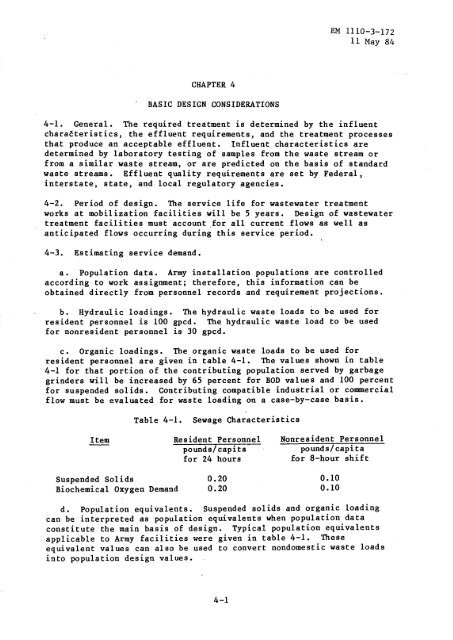Domestic Wastewater Treatment Mobilization Construction - AskTOP
Domestic Wastewater Treatment Mobilization Construction - AskTOP
Domestic Wastewater Treatment Mobilization Construction - AskTOP
You also want an ePaper? Increase the reach of your titles
YUMPU automatically turns print PDFs into web optimized ePapers that Google loves.
EM 1110-3-17211 May 844-3 . Estimating service demand .CHAPTER 4BASIC DESIGN CONSIDERATIONS4-1 . General . The required treatment is determined by the influentcharacteristics, the effluent requirements, and the treatment processesthat produce an acceptable effluent . Influent characteristics aredetermined by laboratory testing of samples from the waste stream orfrom a similar waste stream, or are predicted on the basis of standardwaste streams . Effluent quality requirements are set by Federal,interstate, state, and local regulatory agencies .4-2 . Period of design . The service life for wastewater treatmentworks at mobilization facilities will be 5 years . Design of wastewatertreatment facilities must account for all current flows as well asanticipated flows occurring during this service period .a . Population data . Army installation populations are controlledaccording to work assignment ; therefore, this information can beobtained directly from personnel records and requirement projections .b . Hydraulic loadings . The hydraulic waste loads to be used forresident personnel is 100 gpcd . The hydraulic waste load to be usedfor nonresident personnel is 30 gpcd .c . Organic loadings . The organic waste loads to be used forresident personnel are given in table 4-1 . The values shown in table4-1 for that portion of the contributing population served by garbagegrinders will be increased by 65 percent for BOD values and 100 percentfor suspended solids . Contributing compatible industrial or commercialflow must be evaluated for waste loading on a case-by-case basis .Table 4-1 .Sewage CharacteristicsItem Resident Personnel Nonresident Personnelpounds/capitapounds/capitafor 24 hoursfor 8-hour shiftSuspended Solids 0 .20 0 .10Biochemical Oxygen Demand 0 .20 0 .10d . Population equivalents . Suspended solids and organic loadingcan be interpreted as population equivalents when population dataconstitute the main basis of design . Typical population equivalentsapplicable to Army facilities were given in table 4-1 . Theseequivalent values can also be used to convert nondomestic waste loadsinto population design values .
















